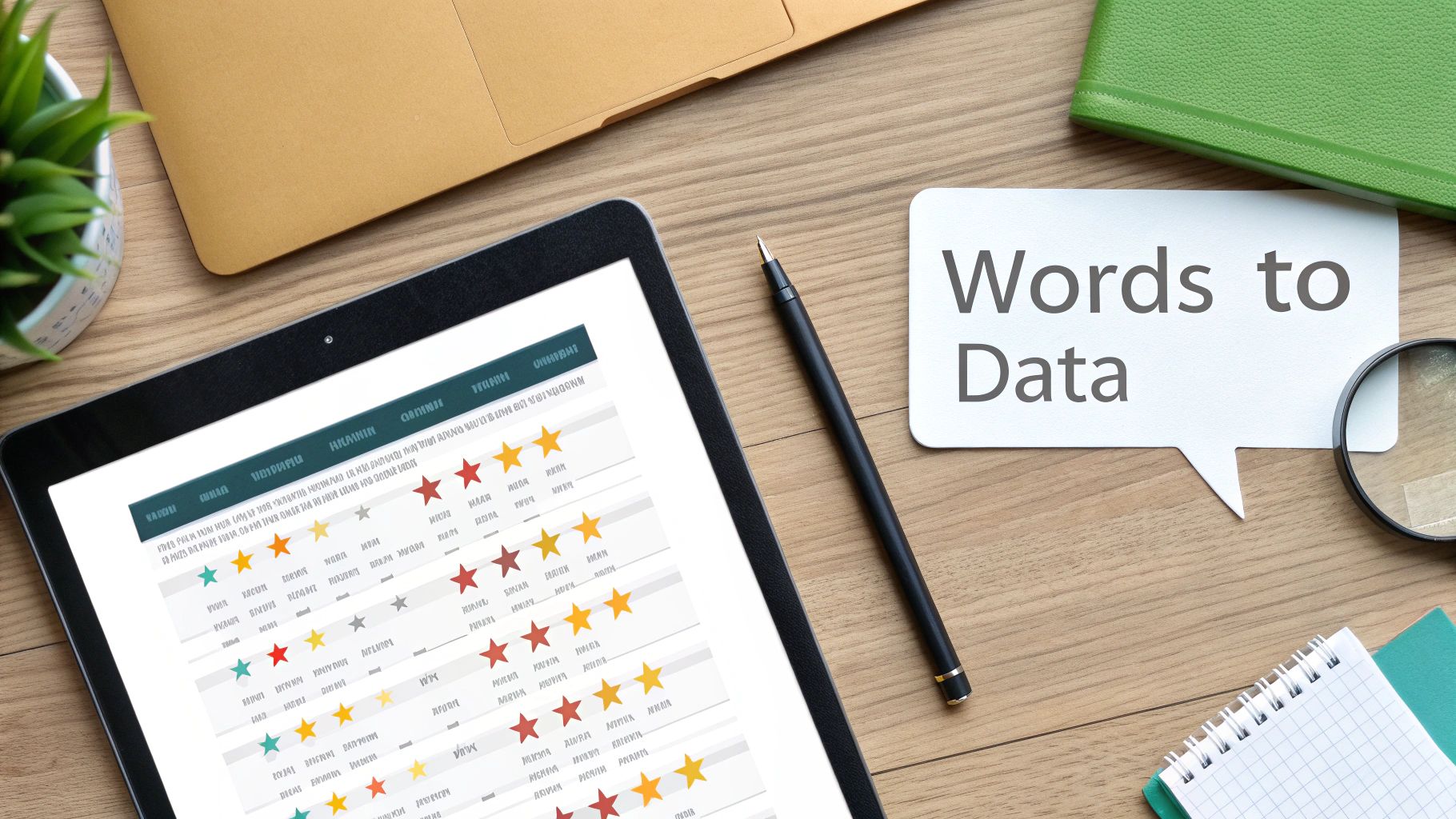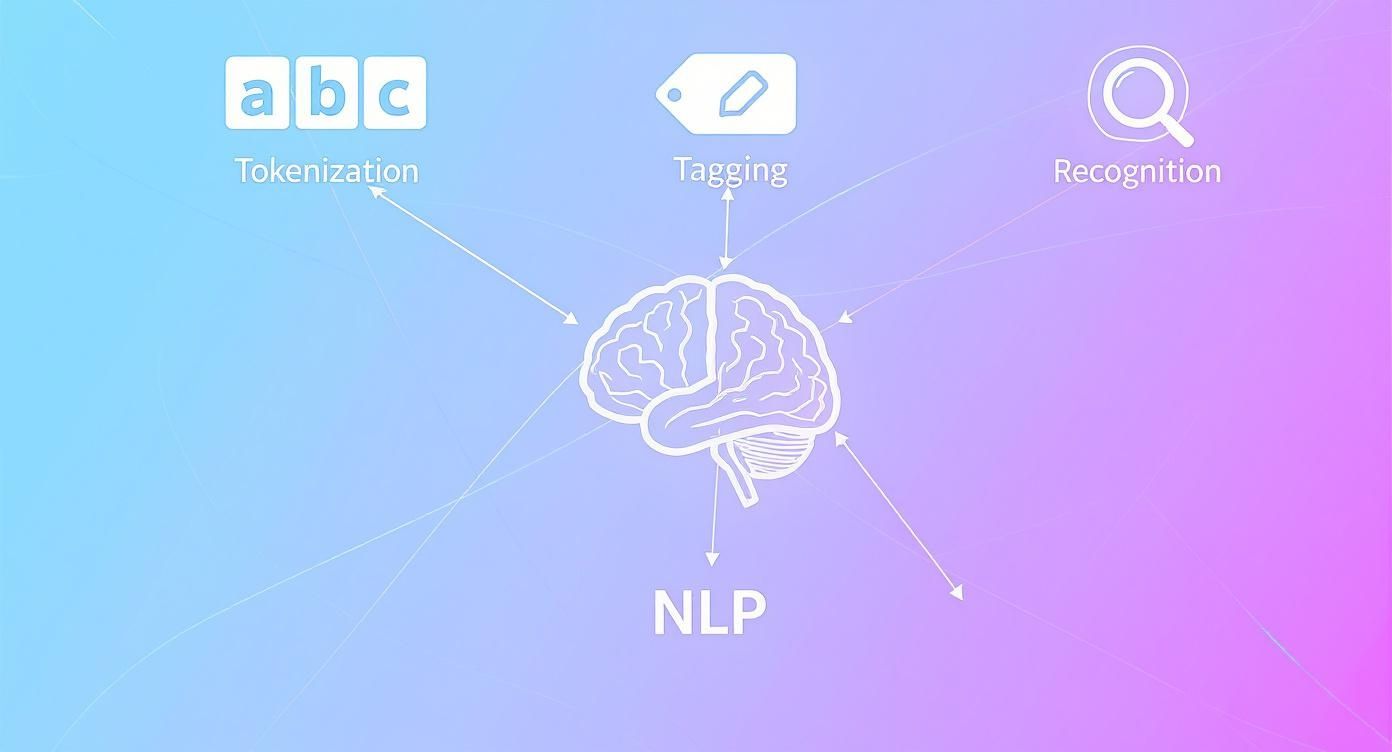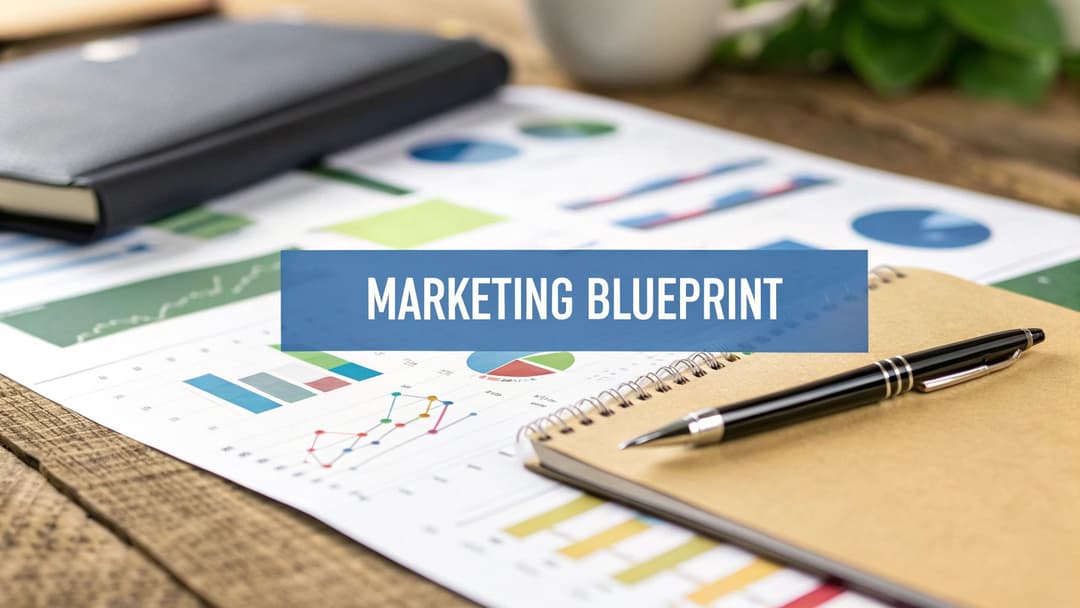
what is text analysis? A Practical Guide to Insights
October 26, 2025
Text analysis is the process of teaching computers to read and understand human language. It's about taking all the messy, unstructured text we create every day—from emails and product reviews to social media rants—and turning it into clean, organized data that a machine can actually make sense of.
Think of it as a universal translator, but instead of translating between French and English, it translates chaotic human language into the structured language of data.
What Is Text Analysis in Simple Terms?

Imagine you’re trying to figure out what thousands of customers think about your new product. You could read every single review, one by one. It would take weeks, and you’d almost certainly miss the bigger picture.
Text analysis is what solves that problem. It’s like a superpower that lets you read, comprehend, and organize all that feedback in seconds, spotting patterns a human eye would never catch. It moves you past simply counting keywords and helps you uncover what people are really trying to tell you.
Turning Words Into Actionable Insights
The real goal here isn't just processing words; it's about digging out the valuable nuggets of information that lead to smarter business decisions. By identifying common themes, understanding public sentiment, and catching new trends before they explode, you get a clear, unbiased view of the conversation.
And this is becoming more critical by the day. The global text analysis market is booming, jumping from USD 4.84 billion to USD 5.85 billion in just a single year. That growth is being driven by the sheer volume of social media data and the urgent need for insights that can improve the customer experience.
Text analysis gives you the "why" behind the numbers. A sales report might tell you what happened, but digging into customer feedback tells you why it happened.
What Can Text Analysis Actually Do?
Let's skip the jargon and focus on what this technology actually helps you accomplish. It’s all about answering important questions.
- Understand Customer Feedback: Got thousands of survey responses? Text analysis can automatically sort them, showing you the top complaints or most-requested features in minutes.
- Monitor Brand Health: You can track mentions across social media to get a real-time pulse on how people feel about your brand—the good, the bad, and the ugly.
- Improve Product Development: By analyzing product reviews, you can pinpoint specific design flaws or find out what improvements customers are begging for.
To break it down even further, here’s a quick look at the core ideas.
Text Analysis At a Glance
This table simplifies the main concepts to give you a quick reference point.
| Component | What It Means | Simple Example |
|---|---|---|
| Sentiment Analysis | Figuring out the emotion or opinion behind the words (positive, negative, neutral). | A review saying "The battery life is a joke" is tagged as Negative. |
| Topic Modeling | Identifying the main themes or subjects in a large amount of text. | Scanning 10,000 hotel reviews to find that the most common topics are "pool," "breakfast," and "staff." |
| Keyword Extraction | Automatically pulling out the most important and relevant words from a text. | From a news article about a product launch, it might extract "new smartphone," "camera," and "release date." |
Each of these components helps turn a mountain of text into something you can actually work with.
This foundational understanding is the first step. Once you grasp these basics, you can start exploring more advanced techniques. For a deeper dive into how this all works in the real world, the v30.ai blog is a great resource. By demystifying the process, you can start to see just how powerful turning words into insights can be.
The Engine Behind Text Analysis: Natural Language Processing
So, how does a computer actually make sense of human language? The magic isn't really magic at all—it's a field of AI called Natural Language Processing (NLP).
Think of NLP as the bridge that connects human language to computer understanding. It’s the set of instructions that teaches a machine to interpret the nuances, context, and intent tucked away inside our words.
This is the same technology that lets your phone’s voice assistant book a reservation and keeps your inbox from overflowing with spam. In text analysis, NLP is the engine that methodically breaks down sentences, figures out how words relate to each other, and gets the text ready for a much deeper look.
How Computers Learn to Read
Before any real analysis can kick off, the computer has to chop up our messy, unstructured language into a format it can work with. This involves a few foundational steps that turn sentences into structured data.
Tokenization: This is ground zero. The software takes a chunk of text and splits it into its smallest pieces, or "tokens." These are typically words and punctuation. The sentence "The service was fast!" becomes a neat little list:
["The", "service", "was", "fast", "!"].Part-of-Speech (POS) Tagging: Next, the machine acts like a grammar teacher, assigning a role to each token. It labels "service" as a noun, "was" as a verb, and "fast" as an adjective. This simple step is huge because it helps the system grasp the grammatical structure of a sentence.
Lemmatization & Stemming: These two processes are all about simplifying words to their core meaning. Words like "running," "runs," and "ran" all get boiled down to their root form, "run." By doing this, the system knows that all these variations are talking about the same basic concept.
These first steps are absolutely critical for bringing order to raw text. Once this groundwork is laid, the system is ready to move on to more sophisticated ways of understanding language.
By deconstructing language into these basic components, NLP gives computers the building blocks they need to understand not just what the words are, but what they mean together.
Spotting What's Important in the Text
With the fundamentals handled, NLP can start doing something really useful: identifying key pieces of information scattered throughout the text.
This is where one of the most powerful techniques, Named Entity Recognition (NER), comes into play. Think of NER as a smart highlighter that automatically scans text to find and categorize specific names and concepts.
It can pinpoint things like:
- People: "Steve Jobs" or "Jane Doe"
- Organizations: "Apple Inc." or "Red Cross"
- Locations: "New York" or "Mount Everest"
- Dates and Times: "December 25th" or "last quarter"
- Products: "iPhone 15" or "Model S"
The power here is pretty clear. Imagine you could instantly pull every company name mentioned across thousands of news articles or flag every product complaint buried in customer support tickets. To get a better feel for how all these techniques fit together, it’s worth exploring a full guide on what is natural language processing.
By singling out these critical details, text analysis tools turn a wall of words into structured data you can actually use for meaningful insights.
Diving Into the Core Text Analysis Techniques
Once a computer understands the basic nuts and bolts of language, it can start doing some seriously powerful work. This is where we go beyond just taking sentences apart and begin pulling real, concrete insights out of the text itself.
Let’s look at a few of the most common—and most impactful—text analysis techniques businesses are using right now. Think of them as specialized tools in a toolbox, each one designed to answer a different kind of question about your data. They don't just read the words; they uncover the meaning, feelings, and big ideas hiding in plain sight.
The infographic below shows how those foundational NLP tasks we talked about make these more advanced methods possible.

As you can see, things like tokenization and tagging are the essential groundwork. You have to get that right before you can dig any deeper.
Gauging Emotion with Sentiment Analysis
One of the most popular techniques out there is sentiment analysis, sometimes called opinion mining. Its job is simple but powerful: read a piece of text and figure out the emotion behind it. Is the author happy, upset, or just neutral?
Picture a hotel chain getting thousands of online reviews every single day. No human team could possibly read them all. But with sentiment analysis, they can process all that feedback automatically and get a bird's-eye view of customer happiness. A sudden spike in negative comments could flag a problem at a specific hotel—maybe a broken AC unit or slow service—letting them jump on it right away.
By quantifying subjective feedback, sentiment analysis turns thousands of opinions into a clear, measurable metric that tracks brand health and customer satisfaction in real-time.
This is so much more than a simple star rating. It digs into the words people are using, catching all the nuance that a 1-to-5 scale completely misses.
Discovering Themes with Topic Modeling
What if you’re sitting on a mountain of text—like years of customer support tickets or a library of research papers—and you don’t even know what the main themes are? That’s the exact problem topic modeling was built to solve.
This technique works like an automatic sorting hat for your documents. It scans everything you give it and identifies clusters of words that tend to show up together, grouping them into abstract "topics." You can instantly see what themes pop up most often.
An e-commerce company, for example, could run topic modeling on its product reviews and discover that "shipping delays," "packaging quality," and "return process" are the three things customers talk about most. Just like that, they have a data-backed roadmap showing them exactly where they need to improve. No guesswork needed.
Pinpointing Key Terms with Keyword Extraction
Last but not least, we have keyword extraction. This technique automatically pulls out the most important and relevant words and phrases from a piece of text. It’s a fantastic way to summarize the core ideas of a document in just a handful of terms.
Think of it as an automated highlighter. For a market researcher, this is a goldmine. They can analyze a competitor's blog posts and instantly extract the key terms, giving them a cheat sheet on what concepts are trending and what language the competition is using to win over customers. It’s a quick, efficient way to keep a pulse on the industry and sharpen your own content strategy.
To help you keep these techniques straight, here’s a quick breakdown of how they compare.
Comparing Key Text Analysis Techniques
| Technique | Primary Goal | Example Use Case |
|---|---|---|
| Sentiment Analysis | Determine the emotional tone (positive, negative, neutral) of a text. | A brand monitoring its social media mentions to gauge public perception. |
| Topic Modeling | Identify and group recurring themes or subjects in a large collection of documents. | An airline analyzing customer feedback forms to find common complaints like "lost luggage" or "flight delays." |
| Keyword Extraction | Automatically pull out the most important terms and phrases from a single document. | A news organization summarizing articles by extracting the main subjects for tagging and categorization. |
Each of these methods offers a unique lens through which to view your text, turning a sea of unstructured words into a well-organized source of valuable information.
How Businesses Use Text Analysis in the Real World
The theory behind text analysis is one thing, but seeing it in action is where it really clicks. Across every industry imaginable, companies are using these techniques to stop guessing and start making smart, data-backed decisions that actually move the needle.
It’s all about translating the messy, chaotic voice of the customer into a clear competitive advantage. From e-commerce giants to healthcare providers, text analysis is solving real problems by digging into product reviews, patient feedback, and even internal emails to find insights that lead to better products and happier customers.
Improving Products with Customer Feedback
Picture an e-commerce brand that just launched a new pair of headphones. A month later, they’re buried under thousands of online reviews. Reading them all one-by-one? Impossible. But with text analysis, they can process all that feedback in an instant.
The system might use topic modeling and quickly find that a ton of reviews mention "uncomfortable fit" and "poor battery life." It can then pull out specific keywords, like “headband is too tight” or “dies after three hours.” This is gold for the product team. They get direct, actionable feedback to fix design flaws in the next production run, saving them from a flood of bad reviews and costly returns.
By analyzing the unstructured text of reviews, the company gets a clear, unbiased roadmap for product improvement directly from the people who matter most: its customers.
This whole process turns fuzzy opinions into hard data, showing not just what the problems are, but how many people are actually experiencing them. It also gives you a much sharper picture of your target audience, which is crucial for any strategy. For a deeper dive on that, you can check out our detailed guide on what is audience analysis.
Enhancing Patient Care in Healthcare
The power of text analysis isn’t just for retail. In healthcare, organizations use it to sift through patient feedback from surveys, online portals, and social media to improve care. A hospital system could analyze thousands of comments and discover a recurring theme about “long wait times in the emergency room” or “confusing discharge instructions.”
Armed with that knowledge, administrators can take real action. They might adjust staffing schedules to cut down wait times or redesign their patient handouts to be way more straightforward. It’s a proactive approach that doesn’t just boost patient satisfaction—it can lead to better health outcomes, too.
Mitigating Risk in Financial Services
In the hyper-regulated world of finance, staying compliant is everything. Financial firms use text analysis to automatically scan millions of internal communications—emails, chat logs, you name it—to spot potential compliance risks or fraud. The system can be trained to flag language that hints at insider trading, unauthorized client promises, or other violations.
This kind of automated monitoring helps firms catch problems before they blow up into massive regulatory headaches, saving them from huge fines and a PR nightmare. Think of it as a powerful, always-on tool for proactive risk management.
The global demand for these solutions is climbing fast. While North America still holds the biggest market share thanks to its early jump on data analytics, the Asia Pacific region is set to see the fastest growth. This is largely driven by countries like China and India, where AI adoption is really taking off. You can discover more insights about the text analytics market on mordorintelligence.com.
Uncovering the Strategic Benefits of Text Analysis
So, what’s the big picture here? Beyond just sorting through comments, weaving text analysis into your business strategy gives you a serious competitive edge. It’s all about connecting the dots between what customers are saying and how your company is performing.
The real magic is its ability to turn messy, qualitative feedback—like reviews and support emails—into structured, quantitative data.
This shift means you can finally stop making decisions based on anecdotes and start relying on hard evidence. Instead of guessing what customers want, you can see measurable trends emerge from their own words. That’s a powerful change that lets every department, from product development to marketing, act with real confidence.
Go Deeper Than Just the “What”
One of the greatest gifts of text analysis is its power to reveal the "why" behind customer behavior. Your sales data can tell you what people bought. But analyzing their reviews, survey responses, and support chats tells you why they bought it—or why they didn't.
That deeper understanding is the key to building better products and stronger customer relationships.
By getting to the true voice of the customer, you can align your entire strategy with their actual needs and pain points. This insight is gold for improving everything from user experience to your brand messaging. It also directly impacts your ability to figure out what content is actually working. For more on this, check out our guide on measuring content effectiveness.
Text analysis acts like an always-on focus group, delivering continuous, unfiltered insights directly from your audience without the bias of traditional research methods.
Boost Efficiency and Sidestep Risk
On a purely practical level, text analysis is a massive time-saver. It automates mind-numbing manual tasks, like sorting support tickets by topic or flagging urgent issues in real-time. This frees up your team to focus on solving complex problems instead of getting bogged down in tedious data entry.
It’s also a powerful tool for proactive risk management.
By continuously scanning communications for keywords related to compliance issues or brewing customer complaints, you can spot potential problems before they blow up. This kind of predictive capability is quickly becoming a must-have, which is fueling massive market growth. The global text analytics market, valued at around USD 14.9 billion, is expected to skyrocket to USD 92.4 billion simply because of this rising demand. You can learn more about the growth of the text analytics market on futuremarketinsights.com.
Getting Started with Text Analysis Tools and Practices

Diving into text analysis is more approachable than you might think. You don't need a data science degree to start pulling meaningful insights from all that text. It really comes down to picking the right approach for your goals and how comfortable you are with the tech.
If you’ve got some coding skills under your belt, open-source libraries are a fantastic route. Python’s Natural Language Toolkit (NLTK) and spaCy are pretty much the industry standards, giving you the flexibility to build a completely custom analysis from the ground up.
But for everyone else, there's a growing wave of no-code platforms built specifically for business users. These tools offer clean, simple interfaces where you can upload your data and get visualizations for sentiment, topics, and keywords with just a few clicks. If you're looking to explore different options, the shortgenius platform offers some unique ways to intelligently process and summarize content.
Essential Best Practices for Success
No matter which tool you land on, your success really depends on a few core practices. Just firing up the software without a clear strategy usually leads to results that are more confusing than helpful. A structured approach is what makes sure your efforts actually hit the mark.
The most powerful tool won’t help if you don't know what question you’re trying to answer. A clear objective is the single most important factor for successful text analysis.
Before you even think about uploading a file, always keep these principles in mind. They’ll keep your work focused and impactful.
Define a Clear Business Question: Always start with a specific goal. Are you trying to figure out why customers are leaving? Or maybe you want to pinpoint the top feature requests from product reviews? A focused question acts as your North Star for the entire analysis.
Prepare and Clean Your Data: Real-world text is messy. It's filled with typos, slang, and a ton of irrelevant chatter. Cleaning your data—fixing errors and cutting out the "noise"—is a non-negotiable step if you want accurate results.
Start Simple and Iterate: Don't try to boil the ocean. Kick things off with a straightforward analysis, like basic sentiment scoring. Use what you find there to decide what to do next. Good analysis is a process of discovery, not a one-and-done task.
Of course. Here is the rewritten section, crafted to sound completely human-written and natural, following the provided style guide.
A Few Lingering Questions
To wrap things up, let’s tackle a couple of common questions that usually pop up when people are first getting their heads around text analysis. These should help clear up any lingering confusion.
Is Text Analysis the Same as Text Mining?
Good question. They're often used in the same breath, but there’s a subtle difference.
Think of text analysis as getting answers to questions you already have. You point it at a pile of text and ask something specific, like, "Is the sentiment here positive or negative?" or "What are the key themes in these customer reviews?"
Text mining, on the other hand, is more about discovery. It sifts through massive collections of text to find interesting patterns or connections you didn't even know to look for. It's less about answering known questions and more about uncovering new ones.
Can This Stuff Actually Understand Sarcasm?
Ah, the million-dollar question. Sarcasm and slang are tricky for machines. A basic tool might see the word "great" and automatically tag the sentiment as positive, completely missing the eye-roll in a comment like, "Great, another shipping delay. Just what I wanted."
But the tech is getting smarter. More advanced models don’t just look at individual words; they analyze the surrounding context, punctuation, and even past interactions to get the real meaning. It’s not perfect yet, but it’s improving at a dizzying pace.
The big takeaway here is that the quality of your insights depends entirely on the sophistication of the tool you're using. Simple tools will get tripped up by nuance, but a modern, AI-driven system can catch the subtleties of human expression with surprising accuracy.
Getting better at understanding context is where the future of text analysis is headed, making it a much more reliable way to hear what your customers are really saying.


